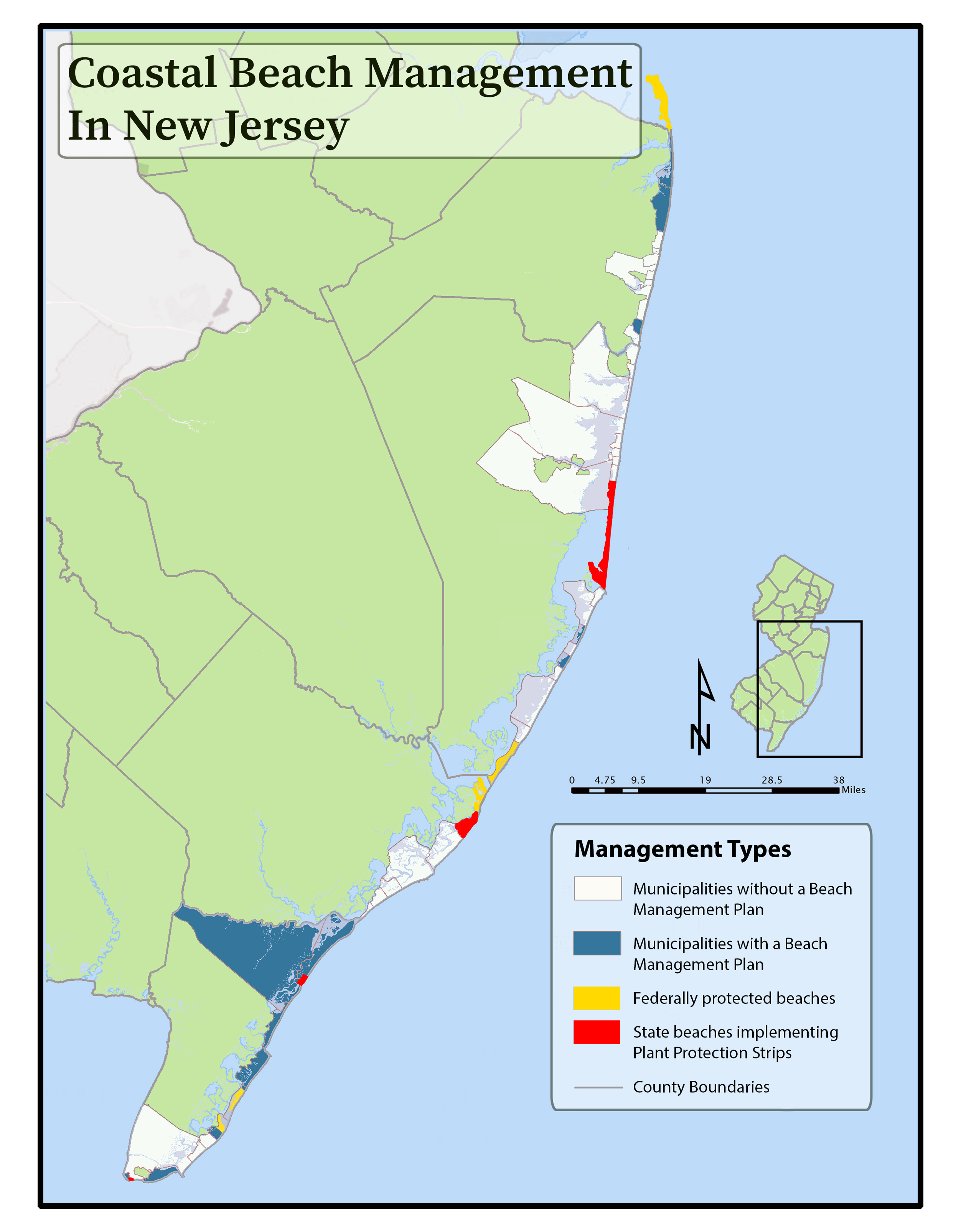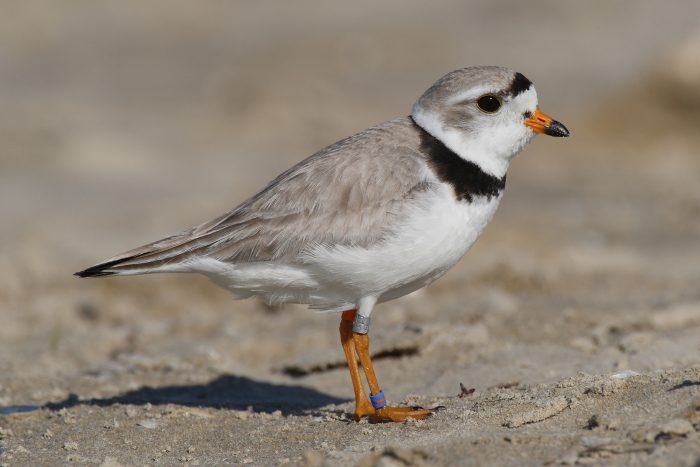The Pinelands Preservation Alliance and Raritan Valley Community College (RVCC) have been working together for over 6 years to protect critical dune habitat along New Jersey’s coast. Grants from the New Jersey Sea Grant Consortium and the National Fish & Wildlife Foundation have made this project possible.
Want to learn more about this program?
Watch the video below to see how dune systems play an integral role in protecting the communities along New Jersey’s coast – especially during major storm events like Hurricane Sandy.
Project Goal
The goal of this project is to proactively improve shoreline community resilience by implementing “compromise management” techniques along the upper beach. This is done by establishing plant protection zones at the foot of the dune where no beach raking or driving is allowed. Raking and all recreational uses are permitted outside of these zones. This allows for the natural development of dunes and the enhancement of habitat for several threatened and endangered plants and animals that depend upon these areas for survival while not having a measurable impact on recreational uses of the beach.
If your town or privately-owned beach does not have a plant protection strips, the Pinelands Preservation Alliance and Raritan Valley Community College would like to partner with you and your town to help manage your beach in a proactive and eco-friendly manner. All public and private entities in Monmouth, Ocean, Atlantic, and Cape May Counties are eligible for this free management opportunity. Please contact your local town council and tell them you’d like to see your town take advantage of this free dune restoration program. We would like to come present in your town.
PPA and RVCC will:
- Install temporary fencing and signage in late April/early May
- Provide maintenance throughout the summer
- Takedown temporary fencing in the Fall
- Provide Educational outreach to your communities on the importance of these practices in the form of news articles, letters, pamphlets, and presentations.
- Monitor/collect data to document the effectiveness of the fencing at stimulating the growth of vegetation and/or sediment accretion
For more information on how to get your community involved please contact Jaclyn Rhoads, Assistant Executive Director for the Pinelands Preservation Alliance by Email jaclyn@pinelandsalliance.org.
Seabeach Amaranth
Seabeach Amaranth was once considered lost from New Jersey. This story map produced by the New Jersey Department of Environmental Protection explains its history and remarkable recovery. This coastal dune project played a big role in this success story.
Project Background
Currently, ecological beach management efforts in New Jersey only encompass a small portion of the coastline. Yet they could be implemented more broadly with little impact on existing recreational uses of the beach. Activities such as fishing, driving, swimming and sunbathing are concentrated towards the lower beach (closer to the water) while beach-nesting birds and beach plants are concentrated towards the upper beach (near the foot of the dune). Traditionally we have only focused our management efforts on protecting the dunes and have largely ignored maintaining our beaches in an eco-friendly manner resulting in driving and/or raking the entire length of the beach profile. Sediment collected on beaches begins the process of forming new dunes and for this reason, managing our beaches is an important piece in protecting our dunes.
This project seeks to implement compromise management that maximizes the benefits for both recreational use and shoreline protection by restricting driving and raking along the back portions of the beach. When the back beach is no longer disturbed during the growing season it begins to develop naturally. Native plants and animals flourish, increasing beach stabilization, without the need to plant native species.
Fostering the natural development of dunes offers substantial rewards for coastal communities at little to no cost. New Jersey has spent well over one billion dollars, more than any other state in the country, on beach replenishment. According to Dr. Jay Kelly, Associate Professor in Biology at Raritan Valley Community College, protected beaches allow for greatly reduced erosion and/or increased sediment deposition compared to beaches that are raked or overridden by vehicles. Our preliminary research suggests that if all of the areas that are currently being mechanically raked along the New Jersey shoreline were managed ecologically, it could reduce beach replenishment costs by as much as $5-10 million per year in the state.
Project Successes
This simple and inexpensive form of management has already produced results. In 2016, the first year of this project, the federally-listed Seabeach Amaranth was found in exclosures in two of the four State Beaches, Island Beach State Park and Brigantine. The state-listed Seabeach Evening Primrose was found in Cape May Point and Corson’s Inlet, Oystercatchers nested in exclosures in North Brigantine Natural Area and Piping Plovers successfully nested in Island Beach for the first time in over 20 years. Protections implemented even longer at Island Beach State Park have greatly enhanced the natural recovery of dunes following Hurricane Sandy.
The Piping Plover again nested at Island Beach State Park in 2017, and Seabeach Amaranth occurred in six locations of improved ecological beach management, including Port Monmouth, Belmar, Island Beach, Harvey Cedars, Brigantine and Corson’s inlet. These are locations that have had few if any Seabeach Amaranth occurrences in the past 16 years and further highlight how impactful the simple measure of protection our upper beaches can be.
2019, was a record year for the Seabeach Amaranth with a 600% increase in abundance over the previous record year, 2018. Nearly 50% of the Amaranth plants found in New Jersey, outside of Sandy Hook, occurred within the exclosures created for this project.


How are Coastal Dunes Created?
Coastal beaches and dunes are dynamic structures created from the interactions of wind, water, and sand. In the summer when waves are calmer, upper beaches contain annual plants, wrack (natural debris), shells, and other natural features. These features disappear in the winter when winds and waves are stronger, washing over the beach. However, when enough sand accumulates, portions of the upper beach start to form young dunes that escape the winter tide. As succession occurs, accumulation of sand buries old plants as new ones grow to allow further build-up of the dune. Strong storm tides may wash away large sections of the upper beach and dunes causing the process to cycle back to the beginning.
Lower Beach: Wrack, natural debris, is deposited at the high tide mark. Due to consistent flooding from the tides, this area of the beach stays unvegetated.
Upper Beach: Storm tides deposit wrack, including seeds, on the upper beach. Infrequent flooding promotes plant growth, resulting in vegetation dominated by sea rocket and seaside spurge.
Mature Dune: As the dunes mature, Amercian beachgrass becomes the predominant vegetation. Mature dunes serve as the first line of defense during storm events.
Creating Habitat for Threatened and Endangered Species
Pioneer beach plants serve the vital function of collecting sand and stabilizing young dunes. Seabeach Amaranth (Amaranthus pumilus), federally threatened, and other state-endangered plants, such as seabeach knotweed and seaside sandwort, utilize the upper beach. Intensive human use of the upper beach results in the destruction of habitat and threatens their survival. Seabeach amaranth was thought to be extinct in New Jersey for over 80 years until it was rediscovered in 2000. Habitat protection has helped keep this plant from becoming locally extinct again.


Piping Plovers (Charadrius melodus) are a federally threatened shorebird. Plovers and other rare birds such as least terns, black skimmers, and American oystercatchers use the upper portion of the beach to nest and rear young. Plovers and other threatened shorebirds, such as the federally threatened Red Knot (Calidris canutus rufa), require the intertidal zone for foraging in preparation for long migrations. Red knots have one of the longest migrations, traveling between the Arctic, where they breed in the summer, to the southern tip of South America, where they over winter. New Jersey’s shoreline is vital in providing the food they need to make their migration successful. Northeastern Beach Tiger Beetles (Cicindela dorsalis dorsalis) are federally threatened and lay eggs in the back beach and upper intertidal zone. Larvae develop in tubular burrows in the intertidal zone and feed on small insects that cross by. Adults retreat to the dunes at night and feed on insects, crabs, and fish in the intertidal zone during the day.